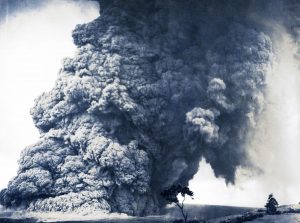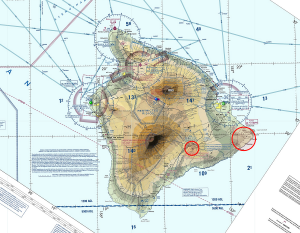
The threat of an explosion at Hawaii’s Kilauea Volcano has prompted additional airspace restrictions, with more travel disruptions possible should ash enter the atmosphere from an explosion event. On May 9, the USGS warned of the potential of a significant steam explosion event at Kilauea’s crater at Hawaii Volcanoes National Park. USGS now warns that such an explosion can happen at any moment starting today. Scientists have signaled the warning after determining that water could mix with the hot magma deep inside Kilauea,creating a large steam-powered explosion deep underground which would explode matter up and away a substantial distance from the Kilauea Caldera. Boulders as large as cars could be launched up, although smaller ash particles could be thrown at much greater distances.
In an evening update a short time ago, the Hawaii County Civil Defense echoed the USGS concerns. They warn a steam-driven eruption “could generate ash plumes as high as 20,000 feet. The area affected by ash plumes could be as wide as 12 miles.”
Should this occur, the following are advised for people on Hawaii’s Big Island by Civil Defense:
- The danger from this eruption is ash fallout. The major response is to protect yourself from fallout.
- If this event occurs while you are at home, stay indoors with the windows closed. Turn on your radio and listen for updates from authorities.
- If you are in your car, keep the windows closed. Ash fallout may cause poor driving conditions, due to limited visibility and slippery driving conditions. Drive with extreme caution, or pull over and park.

Volcanic ash can create problems on the ground and in the sky. Volcanic ash can create significant harm to jet engines that fly through them or boat and automobile engines that ingest air-filled air. Volcanic ash is hard and abrasive, and can quickly cause significant wear to various airplane parts such as propellers, turbo-compressor blades, and even cockpit windows. Because volcanic ash particles have a low melting point, it can melt in the combustion chamber of a jet engine, creating a ceramic or glass-like glaze that then sticks to turbine blades, fuel nozzles, and combustors. A jet engine that ingests just a small amount of ash could suffer from total engine failure. Overheating and engine failure is also possible in cars and trucks since volcanic ash can infiltrate nearly every opening in a vehicle. Ash is also very abrasive; ash caught between windshields and wiper blades will scratch and permanently mark the windshield glass, and windows are susceptible to scratching each time they are raised, lowered, and cleaned.
To keep aircraft away from the ash danger, the National Park Service worked with the FAA to establish a new flight restriction zone that now extends 20,000 feet into the air above the volcano and 12 miles away from it. This joins another Temporary Flight Restriction that restricts non-emergency aircraft and drones from airspace where lava eruptions have occurred in recent days in the Eastern Rift Zone in eastern Hawaii, some 20 miles away from Kilauea.
On the ground, the ash danger could spread to a considerable area, including Hilo International Airport. In the 1924 steam explosion event at Kilauea, ash fell as far north as North Hilo on Hawaii’s northern coast and as far south as southern Kau district on the Big Island’s south coast. Where ash travels will be completely dependent on weather conditions.
The National Weather Service says in the event Kilauea creates an ash loud, NOAA’s Volcanic Ash Advisory Centers (VAAC) will issue critical guidance to help aircraft steer away from destructive ash particles. Beyond that, the National Weather Service office in Honolulu may also issue an Ashfall Advisory or Warning for people on the ground or at sea. NOAA’s VAAC has been providing guidance on remote volcanoes erupting in/around Alaska that could pose an aviation threat too.
No interisland flights, international flights, or flights to/from the US Mainland have been impacted by these alerts yet. However, once an explosion does occur at Kilauea, that will quickly change.